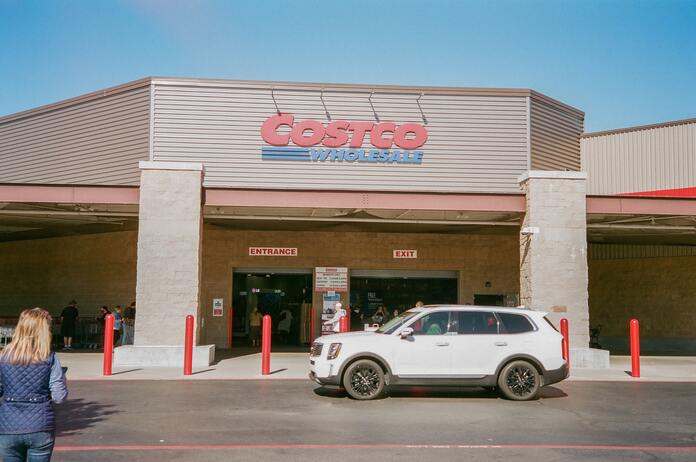Costco Stock (NASDAQ:COST)
The warehouse club known as Costco has established its reputation for offering low pricing while maintaining open communication with its customers.
Both the actual occurrence of inflation, as well as the widespread belief that it is occurring, provides retailers and manufacturers with an excuse to raise prices.
Although there are some legitimate issues that have contributed to increasing pricing, consumers tend to assume that the situation is far direr than it actually is.
According to the most recent dunnhumby Consumer Trends Tracker, “Americans believe that grocery retailers are earning a net profit margin of 35.2%, which is 14 times higher than grocers’ actual net profit margin average of 2.5%; in addition, Americans believe that food-at-home inflation is 24.3%, which is double the annual rate reported by the United States Bureau of Labor Statistics.”
Retailers are free to raise prices whenever they choose if their customers feel that inflation has increased at a rate that is twice as fast as it actually has and that the merchant is making considerably larger profit margins than they actually are.
Costco (NASDAQ:COST) has been quite public about its desire to avoid doing that. Instead, the company has made it one of its primary priorities to maintain low costs in comparison to those of its competitors.
During the earnings call for the second quarter, Costco’s Chief Financial Officer Richard Galanti stated that the company evaluates its own value in comparison to that of its competitors by making frequent (and sometimes daily) purchases at those competitors’ stores in order to conduct comparable shopping.
The corporation bases its pricing decisions on the information in question. He stated that “we are a firm believer [that] if you increase the value by lowering the [price, you’re] going to drive more sales.” “We’re a firm believer [that] if you improve the value by lowering the [price, you’re] going to drive more sales.”
Costco has made significant investments in maintaining pricing stability while also cooperating with its suppliers to achieve the same goal. Now, the shop has been quite honest about inflation, something that many other retailers won’t do with their customers because they fear losing business.
An Easing of Inflation Is Seen at Costco
Buying in large quantities and haggling with vendors for more favorable pricing is central to the operation of the Costco business model, which aims to maximize savings for the company’s customer base. Yet, in the event that inflation takes place, it has the potential to result in price increases for a variety of goods and services, including the products that Costco sells. This could make it harder for Costco to maintain its low costs, which could have an effect on the purchasing decisions made by Costco’s customers.
Inflation is another factor that may have an effect on the operating expenditures of Costco. For instance, there is a possibility that the cost of raw materials, shipping, and labor may all go up, which could result in an increase in overall prices for Costco. It’s possible that in order to cover these greater costs, Costco will need to increase the pricing of the things it sells, which may influence the purchases that its members make.
Inflation is one of the primary elements that might have a significant impact on the value of Costco stock. Inflation can be defined as an increase in the average level of prices paid for goods and services across an economy over a period of time. It is possible for inflation to have a large effect on businesses, particularly retail establishments like Costco, which are susceptible to its effects.
As inflation takes place, prices of goods and services that businesses buy to resell to clients go up. This is because inflation makes goods and services more expensive. It is possible that as a result of this, businesses like Costco may see an increase in the prices of the products they sell. In the event that Costco is unable to pass on these increased costs to its customers in the form of higher pricing, the company’s profitability may suffer as a result. It’s possible that as a result, the value of Costco stock will go down.
Nonetheless, over its history, Costco has been able to lessen the effect that inflation has had on its operations. It does this in a number of ways, one of which is by utilizing its scale and buying power to negotiate cheaper pricing with the various suppliers it works with. It is common knowledge that Costco purchases products in big numbers, which enables the company to negotiate lower costs than its rivals. In addition, the membership model that Costco uses enables the company to produce a consistent stream of money, which can assist the company in surviving times of high inflation.
In general, Costco and its customers may be affected by inflation in a number of different ways. However, the business model of Costco, which consists of buying in bulk and negotiating cheaper pricing from suppliers, may assist the corporation in mitigating the effects of inflation on its costs and prices. But, if the rate of inflation remains high for an extended period of time, Costco may be forced to modify its prices as well as its business procedures.
During the earnings call, Galanti was extremely forthright about the following point: Inflation has begun to drop.
“Now, a few closing remarks concerning inflation. That appears to be continuing to get better over time” he stated. “To refresh your memory, back in the fourth fiscal quarter, which concluded in August of last year, we calculated that the year-over-year inflation in prices was 8% for the prior fiscal year. During the first quarter of 2018, the estimate, as compared to the same period the previous year, decreased to between 6% and 7%.
According to the purchasers, “in the second quarter, we believe that the corresponding year-over-year inflation number has fallen down to the 5% to 6% level and even a bit lower than that toward the conclusion of the quarter.”
In light of the fact that Costco has not fully passed on price hikes to its clients, this is excellent news for both the customers and the warehouse club. The corporation may keep its pricing the same, or even cut them, while still keeping its profit margins thanks to the lower costs.
The Chief Financial Officer made it quite obvious that the climate has been getting better. While inflation might be used as an excuse to justify price increases, very few businesses choose to publicly adopt a stance like this.
“We are continuing to observe some progress in a great many areas. The prices of commodities are beginning to drop, albeit they have not yet returned to their pre-collapse levels. Despite this, consumers can find some relief in the costs of chicken, bacon, butter, steel, resin, and nuts “he stated.
Walmart Has a Distinct Perspective On Inflation
While Costco anticipates that inflation would decline to the range of 5% to 6% throughout its items from the range of 6% to 7% previously, Walmart (NYSE:WMT) Chief Financial Officer of the corporation, John David Rainey, presented a distinct picture of the supermarket business.
“Inflation remained strong, up in the mid-teens in food categories,” he added, adding that these levels were comparable to those seen in the third quarter.
Later on in the call, Walmart President John Furner stated his agreement with such statements.
“As compared to inflation in the other categories, the rate of increase in the cost of food has been the most tenacious. Hence, we were in the middle of the double digits in Q3, and Q4 hasn’t decreased all that much from where it was “he stated.
Even said, CEO Doug McMillon made an effort to clarify that, despite appearances to the contrary, the rate of inflation has not in fact slowed down.
“And another way to think about it is that dry grocery and consumables are tenacious, mid-double digit, and those are going to just be with us for a while,” he said. “And another way to think about it is that food prices are going up.”
“You will most likely hear inflation numbers that begin to seem lower, but you will need to keep in mind that this is based on a two-year stack of data. This is where things will start to get a bit complicated for you.
“Thus, if inflation and the cost of dry groceries and other consumables only add three or five dollars, that’s on top of the 15 dollars. And this continues to be a concern for the client in terms of the pressure that is placed on their wallet.”
Featured Image:















